Kurban Bayram
Living in Trabzon can get me down. Aside from the three weeks when Kyle was here, my life is pretty monotonous. I wake up and lay in bed for an hour or so, staying in the warm bed trying to motivate myself to take a shower in an ice box. Then I dilly-dally around with several distractions at once, such as trying to find a song in my music collection to play for my students (unsuccessful thus far), pulling all the hair out of my brush or counting all the unmailed postcards I have written (currently 12--written 2 months ago). Then around noon I get ready to go to work. After work, I grab a quick bite to eat and head for the Internet cafe. At some point I drag myself up the hill and go to bed only to start all over again tomorrow.
So having a break from the monotony was nothing less than fantastic.
I flew to Istanbul on the first day of the four-day holiday, and it was really great to get off the plane and be embraced by someone who was happy to see me. I jumped into the car with Bahadir and Neslihan and headed for Chorlu, a city just west of Istanbul in the European side of Turkey, aka Thrace.
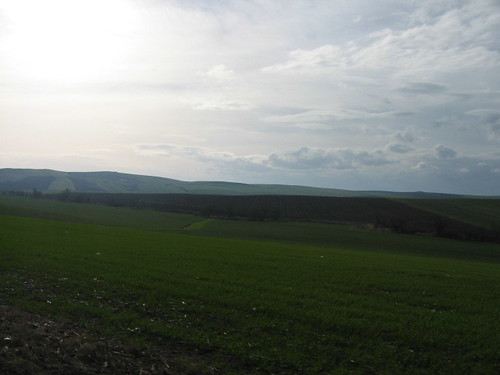
The view was wonderful! Nothing like the mountains around Trabzon. We got to Chorlu around 2 and I met Bahadir's family. Sitting around the kitchen table, his sister asks me,
"Are you a vegetarian?"
"Yes."
"What do you think of Kurban Bayram?"
Kurban Bayram translates roughly to "Feast of the Sacrifice", and commemorates one of the ten trials of Abraham, in which he was called on to kill his own son by God (actually Satan disguised as God). Just as he was about to perform the sacrifice, God stopped him and told him that the sacrifice had already been made. In his son's place, he sacrificed a camel and they feasted.
Before talking with Bahadir and his family extensively about this, I have to admit I thought that the whole affair was rather disgusting and cruel. I felt an incredible sadness that all the animals I had been seeing on the side of the roads would be dead by the weekend.
As Bahadir explained it to me, there are three elements of the sacrifice. The first is the sacrifice of money and physical effort. Animals are expensive, so families go in on one together. Up to 7 families can share one, but this year Bahadir's family split it between four. The total cost was about 2000 YTL (Yeni Turkish Lira), which is about $1500. The physical effort required to deal with the meat is huge. In the morning, the men of the family go to the fields (or where ever the animals are being held) and buy the animal. While they are bargaining, each head of the household shake hands vigoursly with the seller. I saw this on TV and it looks quite funny. Four men on one side and the seller on the other, shaking hands up to shoulder-level and down to hip level, the whole while negotiating price. Once the animal is sold, the families take it to the killing place where they say a prayer, to praise God and bless the animal. I didn't actually see the sacrifice myself for a couple reasons. The first being that my plane came in the afternoon and the sacrifice is a whole day affair, starting after the first morning prayer. Secondly, the men are the ones who take care of that part anyway. As far as I know and understand, women don't participate until the meat comes home.
A word regarding the meat here. The animal must be at least a year old, although larger animals, such as cows or camels, must be at least two years old. It must also be healthy, not ill, pregnant, or otherwise defected. Acceptable animals are camels, cows, and chicken (if one doesn't have a lot of money). Islamic law forbids eating pork, monkeys, dogs, cats, or other carnivores. In fact, the only meat that should be consumed is meat that has been blessed by God. Kosher meat is acceptable.
The killing itself must have good intentions, as this is done for need rather than pleasure. Therefore, the killing must not be performed in a cruel or painful way. The preferred method is cutting the jugular vain so the animal loses blood, goes into shock and loses consciousness, and dies of cardiac arrest.
The whole family participates in cutting up the meat, as is observed in this photograph.
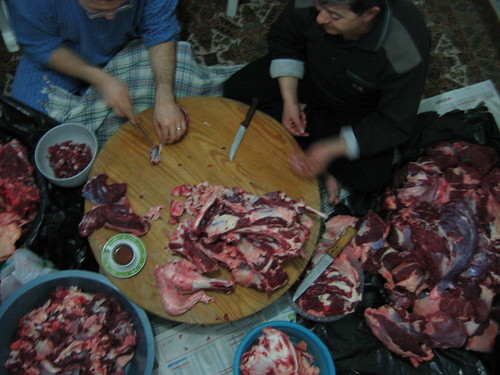
It's a dirty job, but they do it every year.
The second element of the sacifice is to find poor people to give meat to. Many people don't know poor people directly, so finding them can be a job. (I'm not sure if there are agencies that help with this or not, though in this day and age I'm sure there are.) When the poor are found, they have to be convinced to take the meat. People have an honor here that won't allow them to accept something without giving something in return, so convincing someone to take something isn't always easy. (I've tried to convince people to take money from me for instance, but generally to no avail.)
Finally, there is the element of human nature. According to Muslim thinking, humans are innately violent. By sacrificing an animal, the need to kill is satisfied without harming other people.
As I sat there in the kitchen watching all this meat being cut up, it was difficult for me to imagine that all of it had been a living breathing animal that morning. What struck me was the strong connection Turks have with their food. How many Americans cut up the meat they eat? A few, but definitly not the majority. About 60% of Turks sacrifice an animal every year, and what they keep lasts until the next killing.
In other places in Turkey, people were celebrating in the streets. I watched a broadcast from a city on the southern coast called Aslankoy (Lion Village). There was music with drums and a zurna (very loud, double-reeded clarinet without keys--my favorite wind instrument ever), dancing, passing out toys to the children, cooking fires, and eating all kinds of food. They were making garbonzo beans with meat and blood(?), rice and butter, popcorn and roasted garbonzo beans being swept around the cooking surface with a pine needle branch, green kebabs, apple and peach conserve, deep fried sweets, sugary sweets, and gozleme (just to name a few). It all looked really fun and I wanted to go! But that was several thousand kilometers away.
After several hours of working on the meat, they put it away for the night and resumed work in the morning. It was almost never ending!
Around 2 o'clock the next day, Bahadir, his wife Neslihan, his sister Nur, and I piled into his car and headed for Tekirdag (the 'g' is silent), a city known for its Raki. While I didn't get to see where they make the raki (it was a holiday after all), I did get to see the Marmara Sea.
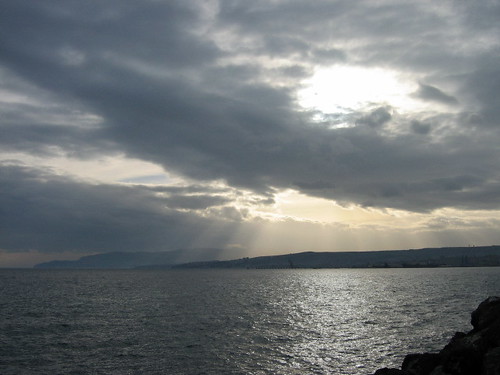
As you can see, it is nothing compared to the Black Sea. Well, maybe you can't really tell. To me, the Marmara Sea is what I imagined living next to water would be like. I look at it and I can breathe. The shores are calm and earthy. The landscape nearby, as you saw, is open and wide. I could walk here for hours! And it would probably feel like I was going nowhere. But damn! Sometimes I feel like I'm suffocating in Trabzon.
On Saturday, we left Chorlu and headed back to Istanbul. We didn't move very quickly because we stopped at almost everyone's house on the way. First some work friends with the cutest 2-year old, then an uncle, another uncle, and finally Neslihan's parents' house. Phew! Eariler in the day, I mentioned something about wanting to buy a Turkish carpet, so Bahadir took me to the Covered Bazaar, but since it was still Bayram, it was closed. No problem, because it was getting dark and the perfect time to do my favorite hobby: nighttime photography!
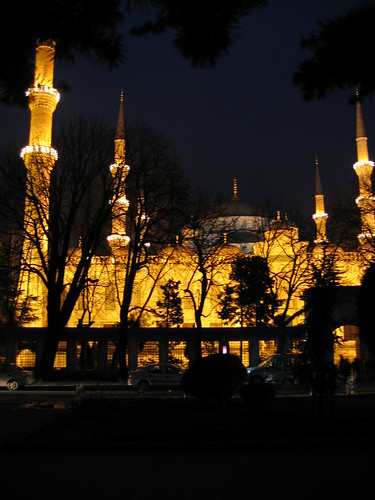
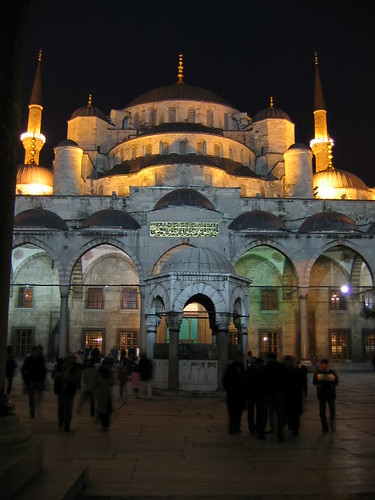
And then we went bowling!
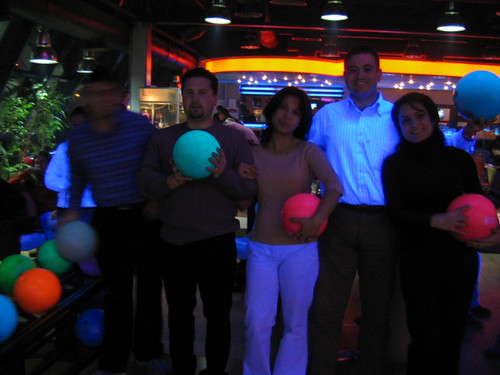
On Sunday I fought my way through the most crowded airport ever and headed back to Trabzon. Walking around the city though, didn't have any sense of homecoming. Nobody is here to greet me, hug me. As I walked through the streets, I found myself walking rather slowly. "Am I tired?" Yes, but not because of any phyiscal activity or because the hour-and-a-half flight was strenuous. I'm tired of Trabzon. Tired of the congestion, the yelling, the honking of horns, the constant city bustle, narrow streets, and lack of city parks.
Right now I'm in the winter slump. Everything is brown, grey, and dingy. Nothing green, nothing beautiful. Once spring arrives (which is around a month and a half from now), I'll head for the mountains and be dazzled by spring colors like I keep seeing advertised in the photo shops. In the meantime, I'm playing the saz and hugging electric heaters.
Ouch! That one was a little hot.
So having a break from the monotony was nothing less than fantastic.
I flew to Istanbul on the first day of the four-day holiday, and it was really great to get off the plane and be embraced by someone who was happy to see me. I jumped into the car with Bahadir and Neslihan and headed for Chorlu, a city just west of Istanbul in the European side of Turkey, aka Thrace.

The view was wonderful! Nothing like the mountains around Trabzon. We got to Chorlu around 2 and I met Bahadir's family. Sitting around the kitchen table, his sister asks me,
"Are you a vegetarian?"
"Yes."
"What do you think of Kurban Bayram?"
Kurban Bayram translates roughly to "Feast of the Sacrifice", and commemorates one of the ten trials of Abraham, in which he was called on to kill his own son by God (actually Satan disguised as God). Just as he was about to perform the sacrifice, God stopped him and told him that the sacrifice had already been made. In his son's place, he sacrificed a camel and they feasted.
Before talking with Bahadir and his family extensively about this, I have to admit I thought that the whole affair was rather disgusting and cruel. I felt an incredible sadness that all the animals I had been seeing on the side of the roads would be dead by the weekend.
As Bahadir explained it to me, there are three elements of the sacrifice. The first is the sacrifice of money and physical effort. Animals are expensive, so families go in on one together. Up to 7 families can share one, but this year Bahadir's family split it between four. The total cost was about 2000 YTL (Yeni Turkish Lira), which is about $1500. The physical effort required to deal with the meat is huge. In the morning, the men of the family go to the fields (or where ever the animals are being held) and buy the animal. While they are bargaining, each head of the household shake hands vigoursly with the seller. I saw this on TV and it looks quite funny. Four men on one side and the seller on the other, shaking hands up to shoulder-level and down to hip level, the whole while negotiating price. Once the animal is sold, the families take it to the killing place where they say a prayer, to praise God and bless the animal. I didn't actually see the sacrifice myself for a couple reasons. The first being that my plane came in the afternoon and the sacrifice is a whole day affair, starting after the first morning prayer. Secondly, the men are the ones who take care of that part anyway. As far as I know and understand, women don't participate until the meat comes home.
A word regarding the meat here. The animal must be at least a year old, although larger animals, such as cows or camels, must be at least two years old. It must also be healthy, not ill, pregnant, or otherwise defected. Acceptable animals are camels, cows, and chicken (if one doesn't have a lot of money). Islamic law forbids eating pork, monkeys, dogs, cats, or other carnivores. In fact, the only meat that should be consumed is meat that has been blessed by God. Kosher meat is acceptable.
The killing itself must have good intentions, as this is done for need rather than pleasure. Therefore, the killing must not be performed in a cruel or painful way. The preferred method is cutting the jugular vain so the animal loses blood, goes into shock and loses consciousness, and dies of cardiac arrest.
The whole family participates in cutting up the meat, as is observed in this photograph.

It's a dirty job, but they do it every year.
The second element of the sacifice is to find poor people to give meat to. Many people don't know poor people directly, so finding them can be a job. (I'm not sure if there are agencies that help with this or not, though in this day and age I'm sure there are.) When the poor are found, they have to be convinced to take the meat. People have an honor here that won't allow them to accept something without giving something in return, so convincing someone to take something isn't always easy. (I've tried to convince people to take money from me for instance, but generally to no avail.)
Finally, there is the element of human nature. According to Muslim thinking, humans are innately violent. By sacrificing an animal, the need to kill is satisfied without harming other people.
As I sat there in the kitchen watching all this meat being cut up, it was difficult for me to imagine that all of it had been a living breathing animal that morning. What struck me was the strong connection Turks have with their food. How many Americans cut up the meat they eat? A few, but definitly not the majority. About 60% of Turks sacrifice an animal every year, and what they keep lasts until the next killing.
In other places in Turkey, people were celebrating in the streets. I watched a broadcast from a city on the southern coast called Aslankoy (Lion Village). There was music with drums and a zurna (very loud, double-reeded clarinet without keys--my favorite wind instrument ever), dancing, passing out toys to the children, cooking fires, and eating all kinds of food. They were making garbonzo beans with meat and blood(?), rice and butter, popcorn and roasted garbonzo beans being swept around the cooking surface with a pine needle branch, green kebabs, apple and peach conserve, deep fried sweets, sugary sweets, and gozleme (just to name a few). It all looked really fun and I wanted to go! But that was several thousand kilometers away.
After several hours of working on the meat, they put it away for the night and resumed work in the morning. It was almost never ending!
Around 2 o'clock the next day, Bahadir, his wife Neslihan, his sister Nur, and I piled into his car and headed for Tekirdag (the 'g' is silent), a city known for its Raki. While I didn't get to see where they make the raki (it was a holiday after all), I did get to see the Marmara Sea.

As you can see, it is nothing compared to the Black Sea. Well, maybe you can't really tell. To me, the Marmara Sea is what I imagined living next to water would be like. I look at it and I can breathe. The shores are calm and earthy. The landscape nearby, as you saw, is open and wide. I could walk here for hours! And it would probably feel like I was going nowhere. But damn! Sometimes I feel like I'm suffocating in Trabzon.
On Saturday, we left Chorlu and headed back to Istanbul. We didn't move very quickly because we stopped at almost everyone's house on the way. First some work friends with the cutest 2-year old, then an uncle, another uncle, and finally Neslihan's parents' house. Phew! Eariler in the day, I mentioned something about wanting to buy a Turkish carpet, so Bahadir took me to the Covered Bazaar, but since it was still Bayram, it was closed. No problem, because it was getting dark and the perfect time to do my favorite hobby: nighttime photography!


And then we went bowling!

On Sunday I fought my way through the most crowded airport ever and headed back to Trabzon. Walking around the city though, didn't have any sense of homecoming. Nobody is here to greet me, hug me. As I walked through the streets, I found myself walking rather slowly. "Am I tired?" Yes, but not because of any phyiscal activity or because the hour-and-a-half flight was strenuous. I'm tired of Trabzon. Tired of the congestion, the yelling, the honking of horns, the constant city bustle, narrow streets, and lack of city parks.
Right now I'm in the winter slump. Everything is brown, grey, and dingy. Nothing green, nothing beautiful. Once spring arrives (which is around a month and a half from now), I'll head for the mountains and be dazzled by spring colors like I keep seeing advertised in the photo shops. In the meantime, I'm playing the saz and hugging electric heaters.
Ouch! That one was a little hot.

3 Comments:
At 4:23 PM, Anonymous said…
Anonymous said…
i miss so many things when i fall behind in my blog reading! congratulations on your big news, first of all! i hope that you and Kyle are deliriously happy together. :) and i loved this entry - it's so interesting to learn about a culture so different from my own. i hope you can shake the winter blahs and get out of Trabzon more often. :)
love,
delana
At 2:43 AM, nicole said…
nicole said…
Ah! I forgot about the money situation here.
Yes, "yeni" means new. As of January 1 this year, the government has issued money without the six zeros after it. People were mentally dropping the zeros long ago, so the government just made it easier.
The extra zeros were causing lots of problems. Calculators weren't big enough to calculate large purchases, like cars or apartments. Can you imagine? A car that sells for $10,000 would be 13,434,999,585.15 Turkish Lira! Back in 1997 when I was here before, you paid for your car in CASH. The biggest denomination was 20 million TL, so imagine bringing all that in cash.
Now they have all kinds of denominations: 100, 50, 20, 10, 5, 1, 1 YTL coins, and they are using kurush again (equivalent to our cents). Only people's grandparents remember using kurush.
At the moment, and for the whole year of 2005, the old bills will be valid. The money is pretty colorful now, and makes me think of the Euro a bit. And of course, all the bills and coins still have pictures of Ataturk on them.
Hmmm, a thought just occured to me. If Turkey joins the EU and takes on th Euro, they'll have to give up Ataturk on all the money. How will that sit with the Turks?
At 11:11 AM, nicole said…
nicole said…
As far as I can tell, the photos on the Euro are pretty set. Check out this website to look at the colorful money.
http://mitglied.lycos.de/habanero/euro/english/index.php
Post a Comment
<< Home